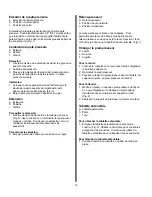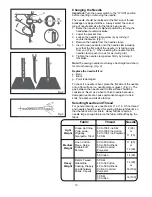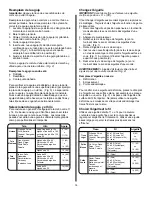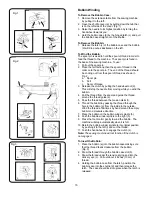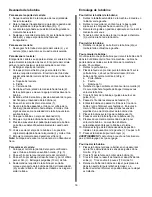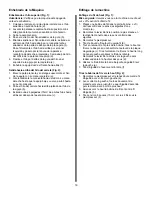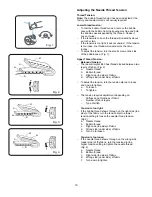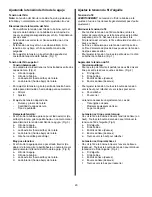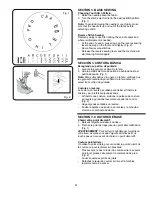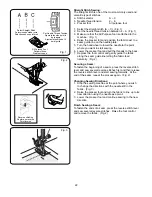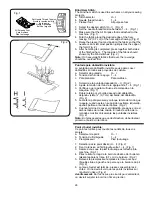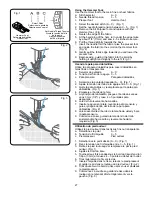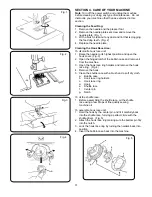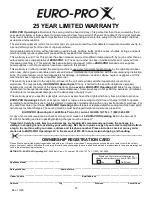
Blind Hem Stitch:
The blind hem stitch is used to sew hems on all your sewing
projects.
a. Stitch selector
H ~ I
b. Needle thread tension
1 ~ 4
c. Presser foot
All purpose foot
1. Select the desired stitch (H ~ I). (Fig. 2)
2. Set the needle thread tension between 1 ~ 4. (Fig. 1)
3. Make sure that the All Purpose foot is attached to the
machine. (Fig. 1)
4. Fold the fabric along the desired edge of the hem,
leaving 1/4” (0.7 cm) of the hem edge showing. (Fig. 2)
5. Raise the presser foot and position the fabric so that the
needle is at its left most position just pierces the edge of
the fold. (Fig. 2)
6. After hemming is completed, press together both sides
of the finished hem. The top side of the fabric should
show only the blind stitches. (Fig. 2)
Note:
On heavyweight fabrics that ravel, the raw edge
should be overcast first.
Puntada para dobladillo invisible:
La puntada para dobladillo invisible se usa para coser
dobladillos en todos sus proyectos de costura.
a. Selector de puntada
H ~ I
b. Tensión del hilo de la aguja 1 ~ 4
c. Pata prensora
Pata multiuso
1. Seleccione la puntada deseada (H ~ I). (Fig. 2)
2. Ajuste la tensión del hilo de la aguja entre 1 ~ 4. (Fig. 1)
3. Verifique que la pata multiuso esté colocada en la
máquina. (Fig. 1)
4. Doble la tela por el borde deseado del dobladillo,
dejando visible ¼” (0,7 cm) del borde del dobladillo.
(Fig. 2)
5. Levante la pata prensora y coloque la tela de modo que
la aguja, cuando esté en su posición extrema izquierda,
apenas perfore el borde del doblez. (Fig. 2)
6. Cuando termine de coser el dobladillo, presione entre si
ambos lados de la tela cosida. El lado de arriba de la
tela debe mostrar únicamente las puntadas invisibles.
(Fig. 2)
Nota:
En telas pesadas que se deshilachan, debe ribetear
primero el borde sin terminar.
Point d’ourlet invisible:
Ce point est utilisé pour coudre les ourlets de tous vos
projets.
a. Sélecteur de point
H ~ I
b. Tension du fil d’aiguille
1 ~ 4
c. Pied-presseur
Pied tout usage
1. Sélectionnez le point désiré (H ~ I). (Fig. 2)
2. Fixer la tension du fil d’aiguille entre 1 ~ 4. (Fig. 1)
3. Assurez-vous que le pied tout usage est attaché à la
machine. (Fig. 1)
4. Pliez le tissu le long de la bordure désirée de l'ourlet en
laissant apparent 1/4po (0,7 cm) de bordure. (Fig. 2)
5. Relevez le pied-presseur et placez le tissu pour que
l'aiguille située à gauche ne perce que la bordure du pli.
(Fig. 2)
6. Lorsque l'ourlet est terminé, pressez ensemble les 2
côtés. On ne devrait voir que les points invisibles sur
l’endroit du tissu. (Fig. 2)
Avertissement: S
ur les tissus plus lourds qui s’emmêlent,
on devrait surjeter le bord non fini en premier.
26
Fig. 1
Fig. 2
All Purpose Foot
Pata multiuso
Pied tout usage
Set Needle Thread Tension
Ajuste la tensión del hilo
de la aguja
Ajustez la tension
de fil de l’aiguille
Summary of Contents for 612C
Page 2: ......

